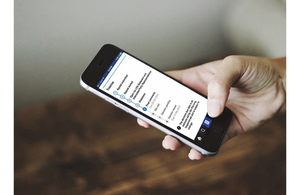 Britain’s cultural treasures could be made accessible from our homes, schools and public libraries thanks to a £19 million government investment.
Britain’s cultural treasures could be made accessible from our homes, schools and public libraries thanks to a £19 million government investment.
image: Open Government Licence v3.0
Gov UK writes:
Investment will give the public the chance to engage and share experiences of interactive exhibitions on an ambitious scale pioneering digital catalogues will facilitate knowledge-sharing and increase access to the best material for the UK’s world-leading research community.
Museum exhibits could soon be viewed in people’s homes, libraries and schools as part of a new £19 million government-backed programme announced on 26 October. The initiative could revolutionise the way visitors can interact with our cultural collections by placing visitors at the heart of exhibits and helping design novel technology and digital tools. These include augmented and virtual reality, sound and interactive exhibits, creating sensory and emotional experiences for visitors. This programme will build on the UK’s reputation as a major tourist destination and leading light in innovative research, creating new possibilities and innovations for museum storytelling and opening up the public’s imagination by bringing together entire collections together online.
UK museums attract millions of visitors every month, while government-sponsored museums make up 7 of the 10 most visited free attractions in the country. The new programme could eventually see art and culture made fully accessible to everyone, with digitisation of cultural collections allowing people across the country to enjoy Britain’s national collections from the comfort of their own home. This could expand cultural treasures to those in remote areas and help local museums – large and small – to engage visitors with innovative, immersive experiences.
Science Minister Chris Skidmore said: ‘Museums can be the perfect fusion between the sciences and the arts, with the creative sector and the humanities working together with new technologies to change how we can experience culture. Creating more ways of seeing and engaging with the treasure trove of experiences available at museums and exhibitions of all kinds means that we are at the forefront of designing the museums of the future. The government is determined to build on this reputation by investing through programmes like this to expand access to our cultural riches. This cutting-edge programme will help UK museums engage visitors with innovative new immersive experiences – as well as supercharging knowledge-sharing within our world-leading research sector. Online interactive tours or live streams would open up the national collection to a diverse audience consuming culture and research – such as younger generations who spend more time online – and would also offer remote access options to those with mobility issues or in rural areas.’
Arts Minister Helen Whately said: ‘Our museums and galleries teach us about our past and help us to better understand the world around us. This funding will see cutting-edge tech enhance the visitor experience, providing exciting new ways for people to explore our history. The programme announced today has the potential to build on the work of previous exhibitions which have plunged visitors into new worlds through technologies such as 3D holograms and artefacts encouraging visitor interaction. The David Bowie exhibition at the V&A, using an innovative 3D audio display attracted more than 1.5 million visitors, while the Leonardo Exhibition at the National Gallery – opening in November – provides visitors with an immersive experience where they can see the layers of a painting using projection technology. Meanwhile, following a separate £4 million government investment earlier this year, content creators Factory 42 will produce 2 multi-sensory, interactive worlds in London’s Natural History Museum and Science Museum to open in 2020. At the Science Museum, visitors will take part in a mixed-reality experience featuring high-resolution 3D images of robots, while the Natural History Museum will bring dinosaurs to life through the story of a palaeontologist’s discoveries.’
John Cassy, CEO, Factory 42 said: ‘Given our work at Factory 42 combining new immersive technology with new ways of storytelling – in projects such as Hold the World with the Natural History Museum and Sir David Attenborough, Painting the Future with the Royal Academy, and now our latest project re-imagining museum experiences at both the Natural History Museum and Science Museum next year – we welcome further opportunities for these iconic institutions to apply ground-breaking technology and content to engage visitors. The new programme also aims to create a centralised, digital collection of research assets to open them up to both students and researchers across the UK, accelerating knowledge-sharing and boosting the UK’s world-leading research community’s capability. Museums across the UK take part in thousands of research partnerships each year including the Natural History Museum’s mosquito data helping to combat the Zika virus. Researchers will identify the best approach for joining up research data and digital assets online to create one, unified collection which is widely available to anyone who wishes to view it. The programme aims to do this by exploring new digital search and cataloguing tools. ‘Discovery’ is an example of an existing online catalogue from The National Archives – which enables searches of archives across the country.’
John Sheridan, Digital Director at The National Archives said: ‘This investment expands our horizons. Through the advanced digital linking of our collections we can transform everyone’s ability to research our nation’s incredible cultural heritage. The £19 million investment from UK Research and Innovation (UKRI) is the latest move by government to ensure the UK remains one of the most attractive places in the world to study and conduct research in the world; as currently 37% of all arts and humanities postgraduate students are from abroad. The announcement follows the government reaffirming its commitment to invest at least 2.4% of GDP in R&D by 2027.’

